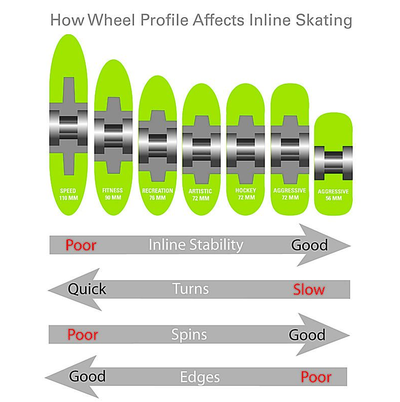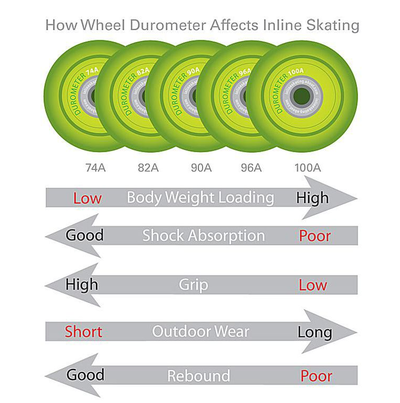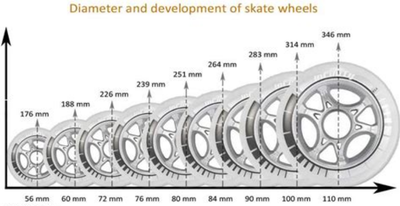Wheel size and type
One of the most common questions asked when buying wheels is: I have a pair of inline skates that need new wheels. What do you recommend?
Technically speaking, by default this is a very hard question to answer when phrased this way and therefore the easiest to answer is: Whats your budget? and take it from there.
However if there is room to play in regards to the budget, you want polyurethane wheels.
Knowing which type of wheel you need is important because it may be the difference between a smooth, comfortable skating experience and a disastrous one. In order to determine the type of wheel you need, you must account for each of the following items:
- Size
- Durometer Rating (hardness)
- Type of Skating
- Skating surface (indoor vs outdoor as well as rough vs smooth)
- Shape
- Skater's experience and skating style
- Boot comfort & design
If you do not account for each of these items you will run the risk of purchasing the wrong wheel. This not only will make for a poor skating experience, but it is also a waste of your money because you will have to replace them faster, again.
In addition to the items listed above, skate wheels also incorporate other elements, including a bearing, bearing spacer, and a hub. To help you locate where each of these items exist, you may review the following image.



Polyurethane
High impact and shock resistance, abrasion resistance, and excellent weatherability have made urethane the choice material for inline skate, roller skate and skateboard wheels. Urethane parts provide longer service life when compared to plastics and rubber, and lower noise abatement properties when compared to metals. For these and many other reasons product engineers specify urethane components.
The higher the quality of the polyurethane is, the better the wheel performs but the more expensive the wheel also is. Inline skating wheels can cost $30~$40 CAD per wheel (2023).
Wheel size
Before selecting a wheel size, you must know the size that fits your skate frame. You can always put smaller wheel but there is a limit when going bigger. You can find information about the wheel size, on your wheel, skate frame and or skate manufacturer's information. The size will be stated in millimitres and they typically range from 56 mm to 130 mm.
As a general rule, a smaller wheel is more maneuverable than a bigger wheel but provides less momentum and requires more effort to maintain speed while a bigger wheel is less maneuverable but allows a lot more speed maintaining more momentum while requiring less effort to maintain.
Hardness
In addition to wheel size, wheel durometer is another important aspect in wheel selection. A wheel durometer is simply the hardness rating of the wheel. Durometer ratings are indicated by a number following by a capital letter A. The hardness scale runs from 0 to 100, with 0 being the softest rating and 100 being the hardest. While the rating scale is from 0 to 100, it is not likely you will find a wheel that has a rating softer than 68A. A wheel softer than this is likely to wear down too fast, regardless of its use.
- The softer the wheel is, the more will stick to the ground due to friction. More friction equals to slower speed but more stability.
- The harder the wheel is, the less it will stick to the ground. Less stickiness equals to more speed but also potential sliding.
- Recommended wheel hardness for the average skater with a body weight between 140 lbs and 200 lbs is 85A for most activities other than aggressive skating.
Profile
The profile is the shape of the wheel. Some wheels are rounder, some are less round and some are pointy (bullet shape)
Generally speaking:
- Less round wheel: More ground contact, more friction, more traction and grip which equals to less speed. (ie: aggressive skating)
- Round wheel: Balanced wheel between the former and the next bellow (ie: recreational, fitness, slalom, hockey, etc)
- Bullet profile: less ground contact, less friction, less grip which equals to more speed. (ie: speed skating)
Core
The purpose of the core of a skate wheel is to prevent the wheel from coming in contact with the bearing and act as an internal stiffener to help the wheel maintain its shape when under stress.
The core of an inline skate wheel is typically made of nylon or plastic but some are aluminum. This will keep the wheel weight at a minimum, and help keep the overall weight of the skate at a minimum as well. A wheel that does not have a hub will deform around the bearing, slowing the wheel as a result.
Wheel cores will vary depending on the type of skate the wheel is designed for. An aggressive skate wheel core is more than likely going to consist of a solid plastic, no spoke design. Comparatively, a racing wheel will typically have a super-light plastic design with many spokes. This design, which is also found in other variation on fitness and recreational skates, is used to make the wheels lighter and allow maximum air flow. As a result, speeds are greater and more air passes through the bearing, allowing it to cool. Keep in mind however that the core design of a speed, fitness, or recreational wheel requires less rubber to compensate for the larger core. This means that the wheels will not last as long, and requires increased attention to wheel maintenance.
Density
Dual density wheels started in 1997 and they provide added grip & shock dampening while lasting longer.
- Core with soft inside and a hard outer PU for Extra long life
- Special mechanical and chemical compounds
- Dual pour
- More rebound than any other wheel in existence allowing for previously unmatched speed
- Suspension and shock absorbing function
- More grip on corners thanks to more footprint
Dual density wheels are also a lot more expensive than regular density wheels.
Rebound
What is wheel rebound and why you want this
Maintenance
Regardless of the type of wheel you use, in order to maintain and expand their life span, you should rotate the wheels on the regular basis according to your skating style and wear.
Proper rotation will keep the wheels in good condition and profile for a long time.